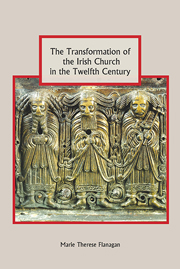Book contents
Conclusion: Universal ideals and regional responses
Published online by Cambridge University Press: 05 October 2013
Summary
By the time Anglo-Norman infiltration into Ireland began in 1167 the Irish church had acquired structures that were broadly in line with those in the rest of Latin Christendom, which itself had undergone rapid and radical transformation in the course of the eleventh and twelfth centuries. Personal and intellectual contacts had been formed with ecclesiastics on the Continent and in England that were highly influential in informing the self-understanding of Irish churchmen in a wider European context. The Irish church was now led by the archbishop of Armagh, who was not only acknowledged as the venerable comarba Pátraic (‘successor of Patrick’) but also accorded an honorial primatial authority that was accepted by the archbishops of Cashel, Dublin and Tuam, and their suffragans, who were responsible for the provision of pastoral care, for jurisdiction over ecclesiastical property and for the oversight of monasteries within their dioceses. Localised churches that may previously have functioned as semi-autonomous units with their own customs and practices were now deemed to be under the authority of a restructured episcopate. A native papal legate in the person of Gillebertus, bishop of Limerick, was in residence from the early decades of the twelfth century and a papal legation under Cardinal John Paparo had presided over a national synod at Kells in 1152, at which pallia for the four archbishops of Armagh, Cashel, Dublin and Tuam had been distributed.
- Type
- Chapter
- Information
- The Transformation of the Irish Church in the Twelfth Century , pp. 243 - 248Publisher: Boydell & BrewerPrint publication year: 2010



